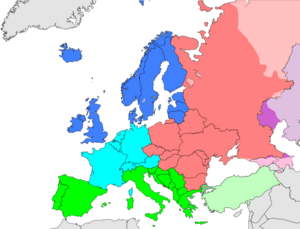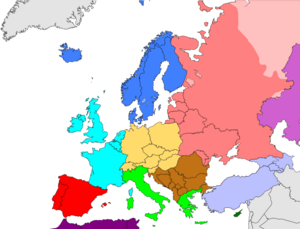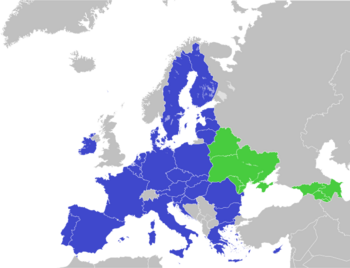Regions of Europe
Topic: Place
 From HandWiki - Reading time: 9 min
From HandWiki - Reading time: 9 min
This article has multiple issues. Please help improve it or discuss these issues on the talk page. (Learn how and when to remove these template messages)
(Learn how and when to remove this template message)No issues specified. Please specify issues, or remove this template. |
Europe, the westernmost portion of Eurasia, is often divided into regions and subregions based on geographical, cultural or historical factors. Since there is no universal agreement on Europe's regional composition, the placement of individual countries may vary based on criteria being used. For instance, the Balkans is a distinct geographical region within Europe, but individual countries may alternatively be grouped into South-eastern Europe or Southern Europe.
Regional affiliation of countries may also evolve over time. Malta was considered an island of North Africa for centuries,[1] but is now generally considered a part of Southern Europe.[2] The exact placement of the Caucasus has also varied since classical antiquity[3] and is now regarded by many as a distinct region within or partly in Europe.[4] Greenland is geographically a part of North America but has been politically and culturally associated with Northern Europe for more than a millennium.[5] As such, several regions are often included as belonging to a Greater Europe, including Anatolia, Cyprus, the South Caucasus, Siberia, Asian Kazakhstan (the part of Kazakhstan located east of European Kazakhstan), Greenland, as well as the overseas territories of EU member states.
Subregions
Groupings by compass directions are the hardest to define in Europe, since there are a few calculations of the midpoint of Europe (among other issues), and the pure geographical criteria of "east" and "west" are often confused with the political meaning these words acquired during the Cold War era.
Some typical geographical subregions of Europe include:
Note: There is no universally agreed definition for continental subregions. Depending on the source, some of the subregions, such as Central Europe or South-eastern Europe, can be listed as first-tier subregions. Some transregional countries, such as Romania or the United Kingdom , can be included in multiple subregions.
Common geopolitical subregions of Europe include:
Two Europes
- Old Europe and New Europe
Three Europes[6]
Historical divisions
Europe can be divided along many differing historical lines, normally corresponding to those parts that were inside or outside a particular cultural phenomenon, empire or political division. The areas varied at different times, and so it is arguable as to which were part of some common historical entity (e.g., were Germany or Britain part of Roman Europe as they were only partly and relatively briefly part of the Empire—or were the countries of the former communist Yugoslavia part of the Eastern Bloc, since it was not in the Warsaw Pact).[citation needed]
- Greek East and Latin West: those parts that fell into the eastern (Byzantine) and Western Roman Empires.[citation needed]
- Catholic and Eastern Orthodoxy in Europe: those parts on either side of the Great Schism.[citation needed]
- After Reformation: countries of Western Christianity (Catholic and Protestant Churches) and Eastern Christianity (Eastern Orthodox Church, Assyrian Church of the East, Oriental Orthodox churches and the Eastern Catholic Churches)[citation needed]
- Protestant and Catholic Europe: those parts that, in the main, left the Catholic Church during the Reformation contrasted with those that did not.[citation needed]
- Communist Europe (Eastern Bloc), Capitalist Europe (Western Bloc): those parts on either side of the Iron Curtain and third world countries (neutral and non-aligned during the Cold War).[citation needed]
Contemporary
Economic and political

- Countries that are member states of the political and economic bloc (27 as of 2023):
- Austria, Belgium, Bulgaria, Croatia, Cyprus, Czech Republic, Denmark , Estonia, Finland , France , Germany , Greece, Hungary, Ireland, Italy, Latvia, Lithuania, Luxembourg, Malta, the Netherlands, Poland , Portugal, Romania, Slovakia, Slovenia, Spain , and Sweden.
- An alliance of Mediterranean countries within EU:
- Croatia, Cyprus, France, Greece, Italy, Malta, Portugal, Slovenia, and Spain.
- Eurozone
- Countries that have adopted the euro as their currency:
- Andorra, Austria, Belgium, Croatia, Cyprus, Estonia, Finland, France, Germany, Greece, Ireland, Italy, Latvia, Lithuania, Luxembourg, Malta, Monaco, the Netherlands, Portugal, San Marino, Slovakia, Slovenia, Spain, and Vatican City.
- A free trade organisation that operates in parallel with, and is linked by treaties to, the EU:
- Liechtenstein, Iceland, Norway, and Switzerland.
- A free trade agreement among non-EU members:
- Albania, Bosnia and Herzegovina, Kosovo (represented by UNMIK), Moldova, Montenegro, North Macedonia, and Serbia.
- Schengen Area
- A borderless zone created by the Schengen Agreements, comprising:
- Austria, Belgium, Croatia, Czech Republic, Denmark, Estonia, Finland, France, Germany, Greece, Hungary, Italy, Latvia, Lithuania, Luxembourg, Malta, the Netherlands, Poland, Portugal, Slovakia, Slovenia, Spain, Sweden; in addition, by separate agreements Norway, Iceland, Liechtenstein, and Switzerland fully apply the provisions of the Schengen acquis.
- European Union Customs Union
- A customs union of all the member states of the European Union (EU) and some neighbouring countries:
- Austria, Belgium, Bulgaria, Croatia, Cyprus, the Czech Republic, Denmark, Estonia, Finland, France, Germany, Greece, Hungary, Ireland, Italy, Latvia, Lithuania, Luxembourg, Malta, Monaco, the Netherlands, Poland, Portugal, Romania, Slovakia, Slovenia, Spain, Sweden. Andorra, San Marino, and Turkey are each in customs union with the EU's customs territory.
- An economic union of Armenia, Belarus, Kazakhstan, Kyrgyzstan, and Russia. Moldova and Uzbekistan hold observer status.
- A free trade agreement among the members of the Commonwealth of Independent States: Armenia, Belarus, Kazakhstan, Kyrgyzstan, Moldova, Russia, and Tajikistan.
- A forum of regional economic cooperation:
- Albania, Armenia, Azerbaijan, Bulgaria, Georgia, Greece, Moldova, Romania, Russia, Serbia, Turkey, and Ukraine.
Other political
- Council of Europe
- An international organisation whose stated aim is to uphold human rights, democracy, and the rule of law in Europe, and to promote European culture.
- It has 46 member states, with approximately 820 million people.
- Eastern European Group
- One of five United Nations regional groups
- Albania, Armenia, Azerbaijan, Belarus, Bosnia and Herzegovina, Bulgaria, Croatia, Czech Republic, Estonia, Georgia, Hungary, Latvia, Lithuania, Moldova, Montenegro, North Macedonia, Poland, Romania, Russia, Serbia, Slovakia, Slovenia, and Ukraine.
- Eastern Partnership and the Euronest Parliamentary Assembly
- A group of former Soviet Eastern European countries cooperating with the EU:
- Armenia, Azerbaijan, Belarus, Georgia, Moldova, and Ukraine.
- European Political Community
- An intergovernmental forum for political and strategic discussions about the future of Europe, with participants from 47 European countries.
- OECD Europe countries
- European countries that are a part of the OECD:
- Austria, Belgium, the Czech Republic, Denmark, Estonia, Finland, France, Germany, Greece, Hungary, Iceland, Ireland, Italy, Latvia, Lithuania, Luxembourg, the Netherlands, Norway, Poland, Portugal, Slovenia, Slovakia, Spain, Sweden, Switzerland, Turkey, and the United Kingdom.
- A forum of regional cooperation including:
- Albania, Austria, Belarus, Bosnia and Herzegovina, Bulgaria, Croatia, the Czech Republic, Hungary, Italy, Moldova, Montenegro, North Macedonia, Poland, Romania, Serbia, Slovakia, Slovenia, and Ukraine.
- A group of former Soviet disputed states in Eastern Europe:
- Abkhazia, South Ossetia, and Transnistria.
- The world's largest security-oriented intergovernmental organization, with 57 participating states mostly in the Northern Hemisphere.
- A cultural and political alliance of four Central European states for the purposes of furthering their European integration, as well as for advancing military, economic and energy cooperation with one another:
- Poland , Czech Republic, Slovakia, and Hungary.
- Centrope
- An Interreg IIIA project to establish a multinational region in Central Europe encompassing four European countries: Slovakia, Austria, Hungary, and the Czech Republic.
- Promotes Central European cooperation.
Geographical
Peninsulas
- Apennine Peninsula (Italian Peninsula)
- Located in the south of Europe, the Apennine Peninsula contains the states of Italy, San Marino, and Vatican City
- The Balkan Peninsula is located in Southeastern Europe and the following countries and territories occupy land within the Balkans either exclusively or partially:
- Albania, Bosnia and Herzegovina, Bulgaria, Croatia (approximately the southern half), Greece, Kosovo, Montenegro, North Macedonia, Romania (the Dobrudja region), Serbia, Slovenia (the coastal section), and Turkey (East Thrace)[citation needed]
- Fennoscandian Peninsula
- Located in the north of Europe, including Finland , Norway , Sweden, and part of Russia [citation needed]
- Located in Southwestern Europe, this peninsula contains Andorra, Gibraltar, Portugal, Spain , and a small part of France [citation needed]
- Jutland Peninsula
- Jutland of Denmark (main part of the country excluding its islands) and the Schleswig-Holstein region of Germany [citation needed]
- Located in the north of Europe, including Norway , Sweden, and part of Finland [citation needed]
Regional
- Baltic Rim region
- Denmark , Estonia, Finland , Germany , Latvia, Lithuania, Poland , Russia , and Sweden[citation needed]
- The term Baltic states generally applies to Estonia, Latvia, and Lithuania
- Guernsey, The Isle of Man, the Republic of Ireland, Jersey and the United Kingdom
- Carpathian states
- Czech Republic, Hungary, Poland , Romania, Serbia, Slovakia, and Ukraine [citation needed]
- Armenia, Azerbaijan, Georgia, and Russia ; also the disputed territories of Abkhazia, and South Ossetia[citation needed]
- Channel Islands
- Guernsey and Jersey
- Belgium, Luxembourg, the Netherlands, parts of France , and parts of Germany [citation needed]
- Benelux: Belgium, the Netherlands, and Luxembourg
- Sweden, Norway , Finland , Denmark , Greenland, and Iceland[citation needed]
- Scandinavia: Sweden, Norway , Denmark [citation needed]
- Fennoscandia: Finland , Sweden, Norway and Karelia; a geological region defined by the Fennoscandian shield[citation needed]
- States that occupy the Alps:
- Austria, Switzerland , Liechtenstein, Slovenia, Germany , France , and Italy[citation needed]
- States that lie along the River Danube:
- Austria, Bulgaria, Croatia, Germany , Hungary, Moldova, Romania, Serbia, Slovakia, and Ukraine [citation needed]
- Overlaps with Southeastern Europe:
- Bulgaria, Greece, Albania, Kosovo, North Macedonia, Bosnia and Herzegovina, Montenegro[citation needed]
- Countries occupying land on and off the Balkans are Romania, Serbia, Croatia, Slovenia, and Turkey (East Thrace).[citation needed]
- Dinaric Alps
- Slovenia, Croatia, Bosnia and Herzegovina, Montenegro, Albania[citation needed]
- Serbia, Kosovo and Italy occupy a small portion of the Dinaric Alps.[citation needed]
- Macaronesia
- Chain of Islands in the North Atlantic
- Azores, Canary Islands, Madeira; also including Cape Verde, an independent African nation.[citation needed]
- Mediterranean countries
- Mediterranean nations are European countries on the Mediterranean Basin:
- Portugal, Spain , France , Monaco, Italy, Slovenia, San Marino, Croatia, Bosnia and Herzegovina, Montenegro, Albania, Greece, Turkey, Cyprus, Malta, and the United Kingdom territory of Gibraltar[citation needed]
- Adriatic region: Italy, Slovenia, Croatia, Bosnia and Herzegovina, Montenegro, Albania[citation needed]
- Pannonian countries
- The Panonnian nations are:
- Austria, Croatia, Hungary, Romania, Serbia, Slovakia, Slovenia, and Ukraine [citation needed]
- Black Sea region
- The Black Sea nations (although some sections lie within Asia) are:
- Abkhazia (de facto state), Bulgaria, Georgia, Romania, Russia , Turkey, and Ukraine [citation needed]
- Caspian Sea region
- The world's largest lake which forms a section of the Asian-European border has five countries occupying its shore. Iran and Turkmenistan lie entirely within Asia while the following countries are transcontinental and have sovereignty over the Caspian Sea's European sector:
- Azerbaijan, Kazakhstan, and Russia [citation needed]
Other groupings
- Blue Banana: describing the concentration of the wealth/economic productivity of Europe in a banana-shaped band running from north west England, London, through Benelux, eastern France, western Germany to northern Italy.
See also
- Assembly of European Regions
- Enlargement of the European Union
- European integration
- Geography of Europe
- Politics of Europe
- Politics of the European Union
- Potential enlargement of the European Union
- United Nations geoscheme for Europe
References
- ↑ Falconer, William; Falconer, Thomas (1872). Dissertation on St. Paul's Voyage. BiblioLife. p. 50. ISBN 978-1-113-68809-5. https://books.google.com/books?id=B3Q29kWRdtgC&pg=PA50. Retrieved 23 May 2018.
- ↑ Chapman, David; Cassar, Godwin (October 2004). "Valletta". Cities 21 (5): 451–463. doi:10.1016/j.cities.2004.07.001.
- ↑ Histories 4.38. C.f. James Rennell, The geographical system of Herodotus examined and explained, Volume 1, Rivington 1830, p. 244
- ↑ Encyclopædia Britannica”, Caucasus, June 2021: “another scheme identifies the Aras River and the Turkish border as the line of continental demarcation, thereby locating Armenia, Azerbaijan, and Georgia in Europe.”
- ↑ Dale Mackenzie Brown. "The Fate of Greenland's Vikings" . Archaeological Institute of America: 28 February 2000
- ↑ F. Braudel, Preface to Szucs J., Les trois Europes, Paris 1990
External links
 |
 KSF
KSF



